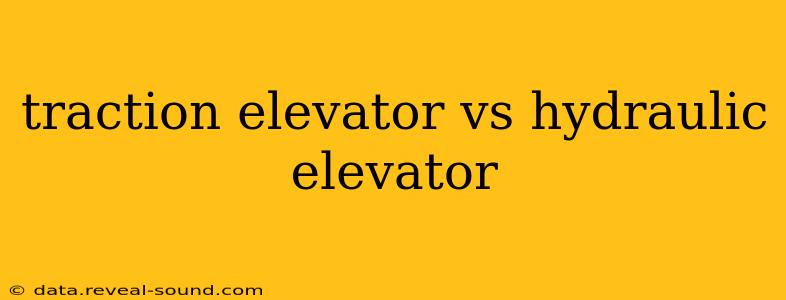Traction Elevators vs. Hydraulic Elevators: A Comprehensive Comparison
Choosing the right elevator system for a building is a crucial decision, impacting efficiency, cost, and long-term maintenance. Two primary types dominate the market: traction elevators and hydraulic elevators. While both achieve the same goal – transporting people and goods vertically – their mechanisms, advantages, and disadvantages differ significantly. Understanding these differences is key to making an informed choice.
What is a Traction Elevator?
Traction elevators use a system of cables, counterweights, and a motor to move the elevator car. The motor drives a sheave (a grooved wheel) that the cables wrap around. The counterweight balances the weight of the car, reducing the energy required to move it. This design is ideal for tall buildings, offering efficient and smooth operation.
What is a Hydraulic Elevator?
Hydraulic elevators utilize a piston and a hydraulic cylinder filled with fluid (usually oil). The piston is connected to the elevator car, and the motor pumps fluid into the cylinder, raising the car. To lower the car, the fluid is released, allowing gravity to assist in the descent. This system is typically employed in low-rise buildings.
How Do Traction and Hydraulic Elevators Differ?
The core distinctions lie in their mechanisms, energy efficiency, speed, maintenance needs, and suitability for different building heights. Let's break down these key differences:
1. Mechanism of Operation:
- Traction: Uses cables, counterweights, and a motor to move the elevator car.
- Hydraulic: Uses a piston, hydraulic cylinder, and pressurized fluid to raise and lower the car.
2. Speed and Height:
- Traction: Can achieve much higher speeds and operate in taller buildings (often exceeding 20 stories). They offer faster and more efficient transportation for multi-story structures.
- Hydraulic: Generally limited to lower speeds and shorter travel distances (typically less than six stories). Their slower speed and limited height capabilities restrict their use in tall buildings.
3. Energy Efficiency:
- Traction: Generally more energy-efficient, especially for taller buildings, due to the counterweight system. They consume less energy per trip, resulting in lower operating costs over time.
- Hydraulic: Can be less energy-efficient, particularly during repeated short trips. Energy is lost in the process of pumping and releasing hydraulic fluid.
4. Maintenance and Costs:
- Traction: Requires regular maintenance of cables, sheaves, and motors. However, maintenance costs are often lower in the long run, especially relative to energy consumption.
- Hydraulic: Requires maintenance of the hydraulic system, including fluid changes, seal replacements, and potential leaks. This can sometimes lead to higher maintenance costs, particularly as the system ages. The need for frequent fluid changes and potential environmental concerns related to hydraulic fluid disposal are important factors to consider.
5. Environmental Impact:
- Traction: Generally considered more environmentally friendly due to higher energy efficiency and lower reliance on hydraulic fluids.
- Hydraulic: The use of hydraulic fluids raises environmental concerns, although advancements in environmentally friendly fluids are being developed.
6. Installation and Space Requirements:
- Traction: Requires a machine room located at the top of the hoistway, potentially needing more space.
- Hydraulic: The hydraulic pump unit can sometimes be located outside the hoistway, potentially saving space. However, the hydraulic cylinder requires significant space within the ground.
What are the advantages of each elevator type?
Traction Elevators:
- Higher speeds: Faster transportation, ideal for high-rise buildings.
- Greater height capacity: Suitable for tall buildings.
- Energy efficiency: Lower long-term energy costs.
- Smoother operation: Generally provides a more comfortable ride.
Hydraulic Elevators:
- Lower initial cost: Typically less expensive to install than traction elevators, particularly for low-rise buildings.
- Simpler system: Fewer moving parts, potentially leading to less complex maintenance, although it may require more frequent service intervals.
- Compact machine room: The hydraulic power unit may be located remotely, potentially saving space.
What are the disadvantages of each elevator type?
Traction Elevators:
- Higher initial cost: More expensive to install initially.
- More complex system: Requires specialized maintenance.
- Requires machine room: Needs dedicated space at the top of the hoistway.
Hydraulic Elevators:
- Lower speeds: Not suitable for high-rise buildings.
- Lower height capacity: Limited to low-rise buildings.
- Lower energy efficiency: Higher energy consumption, leading to potentially higher long-term costs.
- Environmental concerns: The use of hydraulic fluids raises environmental issues.
Which type of elevator is right for me?
The optimal choice depends on several factors, including building height, budget, energy efficiency requirements, and maintenance considerations. High-rise buildings almost always necessitate traction elevators due to their speed and height capabilities. Low-rise buildings offer more flexibility, with hydraulic elevators being a viable option for certain projects if the budget prioritizes a lower initial cost. Consulting with an elevator professional is crucial for a tailored recommendation based on your specific project needs.
